
Manta rays are large rays belonging to the genus Mobula. The larger species, M. birostris, reaches 7 m (23 ft) in width, while the smaller, M. alfredi, reaches 5.5 m (18 ft). Both have triangular pectoral fins, horn-shaped cephalic fins and large, forward-facing mouths. They are classified among the Myliobatiformes and are placed in the family Myliobatidae. They have the largest brains and brain to body ratio of all fish, and can pass the mirror test.

Rajiformes is one of the four orders in the superorder Batoidea, flattened cartilaginous fishes related to sharks. Rajiforms are distinguished by the presence of greatly enlarged pectoral fins, which reach as far forward as the sides of the head, with a generally flattened body. The undulatory pectoral fin motion diagnostic to this taxon is known as rajiform locomotion. The eyes and spiracles are located on the upper surface of the head and the gill slits are on the underside of the body. Most species give birth to live young, although some lay eggs enclosed in a horny capsule.
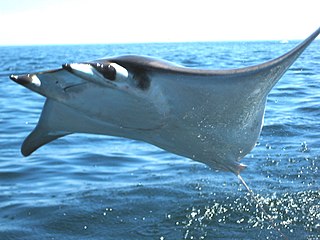
Mobula is a genus of rays in the family Mobulidae that is found worldwide in tropical and warm, temperate seas. Some authorities consider this to be a subfamily of the Myliobatidae. Their appearance is similar to that of manta rays, which are in the same family, and based on genetic and morphological evidence, the mantas belong in Mobula. Species of this genus are often collectively referred to as "devil rays", "flying mobula", or simply "flying rays", due to their propensity for breaching, sometimes in a spectacular manner. These rays gather in groups and leap out of the surface into the air up to around two metres before splashing back into the water.
The spearfish remora is a species of remora with a worldwide distribution in tropical and subtropical seas. Remoras attach themselves to other fish with a sucker on the head and this fish is almost exclusively found living on billfishes or swordfishes, and sometimes on sharks.

The longheaded eagle ray is a species of eagle ray in the family Myliobatidae. The longheaded eagle ray, like other members of the genus Aetobatus, is characteristically different from other genera of eagle rays, distinguished by their notched nasal curtain; complete, singular set of upper and lower teeth; and v-shaped teeth in the lower jaw. It is found in the tropical and warm temperate Indo-West Pacific. It formerly included populations in the northwest Pacific, but these were recognized as a separate species, Aetobatus narutobiei, in 2013. Longheaded eagle rays are benthopelagic fishes that feed on crustaceans, cephalopods, echinoderms, and small bony fishes. It is a poorly known species, but generally uncommon and considered endangered by the IUCN.

The longtail butterfly ray is a species of butterfly ray, family Gymnuridae, native to the Indo-Pacific from the Red Sea to southern Japan and western Indonesia. Growing up to 92 cm (36 in) across, this ray has a lozenge-shaped pectoral fin disc about twice as wide as long, colored brown to gray above with many small, light spots. The spiracles behind its eyes have smooth rims. This species can be identified by its tail, which is about as long as the snout-to-vent distance, lacks fins, and bears nine to twelve each of alternating black and white bands.
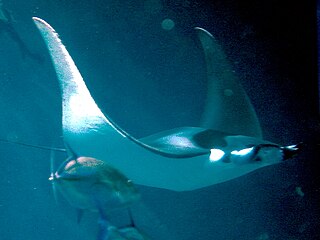
The spinetail devil ray, also known as the spinetail mobula ray or Japanese mobula ray, is a species of pelagic marine fish which belongs to the family Mobulidae. It is found throughout the tropical and sub-tropical waters of the Indo-Pacific and eastern Atlantic Ocean.

Mobula munkiana, commonly known as the manta de monk, Munk's devil ray, pygmy devil ray, smoothtail mobula or Munk’s pygmy devil ray is a species of ray in the family Mobulidae. It is found in tropical parts of the eastern Pacific Ocean, ranging from the Gulf of California to Peru, as well as near offshore islands such as the Galapagos, Cocos, and Malpelo. Munk's devil ray was first described in 1987 by the Italian ecologist Giuseppe Notarbartolo di Sciara and named for his scientific mentor, Walter Munk.

The Chilean devil ray, also known as the box ray, greater Guinean mobula, sicklefin devil ray or the spiny mobula, is a species of ray in the family Mobulidae. It is often observed worldwide, basking just below the surface in tropical, subtropical and warm temperate oceans, mainly offshore, and occasionally appearing near the coast. It can reach a disc width of up to 3.7 m (12 ft).

The Gulf torpedo or variable electric ray, is a species of electric ray in the family Torpedinidae. It is found in the Indian Ocean, but may represent a species flock of several local endemic species. It is distinguishable from other Torpedo species in its range by its ornate dorsal coloration. Another common name, marbled electric ray, is not to be confused with Torpedo marmorata.
Sicyopterus lagocephalus, the red-tailed goby or blue stream goby, is a species of goby native to islands of the Indian Ocean from the Comoros to the Mascarene Islands to the Pacific Ocean where it reaches French Polynesia and can be found as far north as Japan. It is an amphidromous species: adults can be found in swift-flowing streams with rocky beds but the eggs hatch at sea and the larval stage remains in marine waters, migrating to freshwaters when they reach the postlarval stage. This species can reach a total length of 13 cm (5 in). In some places it is an important species for local consumption with the post-larvae being caught as they mass in estuaries.
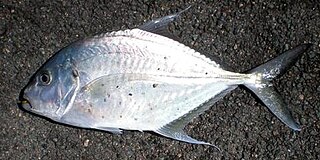
The longnose trevally, also known as the tea-leaf trevally, club-nosed trevally, grunting trevally or dusky trevally, is a species of inshore marine fish in the jack family, Carangidae. The species is distributed throughout the tropical and subtropical waters of the Indian and west Pacific Oceans from South Africa to New Zealand and Japan, inhabiting coastal waters, especially reefs, to a depth of 90 m. The longnose trevally is distinguished from similar species by a combination of a scaleless breast and the number of gill rakers and fin rays. It is a moderately large fish, growing to a maximum known length of 72 cm and 4.35 kg. The longnose trevally is a predatory fish, consuming small fish, crustaceans and molluscs. The species is of minor commercial importance throughout its range, and is considered to be a good table fish.
The Hortle's whipray is a little-known species of stingray in the family Dasyatidae, occurring in shallow estuaries and mud flats off southern New Guinea. This species, growing to 71 cm (28 in) across, has a heart-shaped pectoral fin disc with a long, pointed snout and minute eyes. It has a wide dorsal band of dermal denticles extending from in front of the eyes to the tail, as well as scattered sharp denticles on the snout. The underside of the disc is a distinctive bright yellow in color, sometimes with darker markings around the nostrils, mouth, and gill slits. The Hortle's whipray is threatened by extensive seine fisheries and habitat degradation, leading the International Union for Conservation of Nature (IUCN) to assess it as Near Threatened.

Blennophis striatus, the Striped klipfish, is a species of clinid found in the subtropical waters of the Atlantic Ocean from Saldanha Bay to East London, South Africa where it can be found in the subtidal zone as well as inhabiting tidepools. This species can reach a maximum length of 17.5 centimetres (6.9 in) TL.

The Indonesian angelshark is a rare species of angelshark, family Squatinidae, known only from a few specimens collected from fish landing sites in southern Indonesia. It is thought to inhabit the deep waters of the continental slope. Reaching at least 1.34 m (4.4 ft) long, this species has a flattened, ray-like shape and a well-developed tail and caudal fin. It is characterized by the absences of fringes on its nasal barbels and thorns down the midline of its back, as well as by its relatively plain grayish-brown dorsal coloration with dark saddles beneath the dorsal fin bases and a black leading margin on the underside of the pectoral fins. The International Union for Conservation of Nature (IUCN) has classified it as Critically Endangered due to significant fishing pressure.

The giant oceanic manta ray, giant manta ray, or oceanic manta ray is a species of ray in the family Mobulidae, and the largest type of ray in the world. It is circumglobal and is typically found in tropical and subtropical waters, but can also be found in temperate waters. Until 2017, the species was classified in the genus Manta, along with the smaller reef manta ray. DNA testing revealed that both species are more closely related to rays of the genus Mobula than previously thought. As a result, the giant manta was renamed as Mobula birostris to reflect the new classification.

The reef manta ray is a species of ray in the family Mobulidae, one of the largest rays in the world. Among generally recognized species, it is the second-largest species of ray, only surpassed by the giant oceanic manta ray.
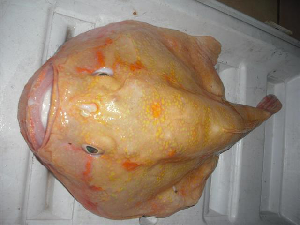
The coffinfish or furry coffinfish is a species of sea toad of the family Chaunacidae. It is found in salty temperate waters of southwestern Pacific, off east coast of Australia. The coffinfish was first discovered around February 1997 in Sicily, Italy by the skipper of the Libra, which was a trawler who was harbored in Mazara at the time. It can be also found in depths of 50–300 m (164–984.3 ft). Deep sea crab fishermen off the east coast of Florida pull them up from depth ranging from 5,000–8,000 feet about 54–68 miles off the coast. They have a globose and spiny body that grows to a maximum length of 22.0 cm (8.7 in) and a black mouth lining and an illicium on the snout that can be lowered into a groove.
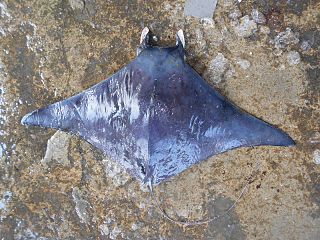
Mobula kuhlii, the shortfin devil ray, is a species of ray in the family Mobulidae. It is endemic to the Indian Ocean and central-west Pacific Ocean. It ranges from South Africa, Mozambique, Tanzania and the Seychelles in the west to the Philippines and Indonesia in the east, and southward to the northern coast of Australia.
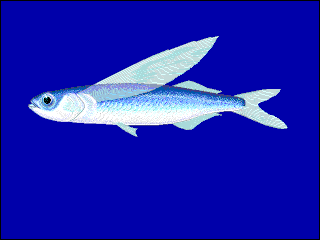
Exocoetus volitans, commonly known as the tropical two-wing flyingfish or blue flyingfish, is a species of ray-finned fish native to tropical and subtropical seas. It can glide above the surface of the sea to escape predators.

















